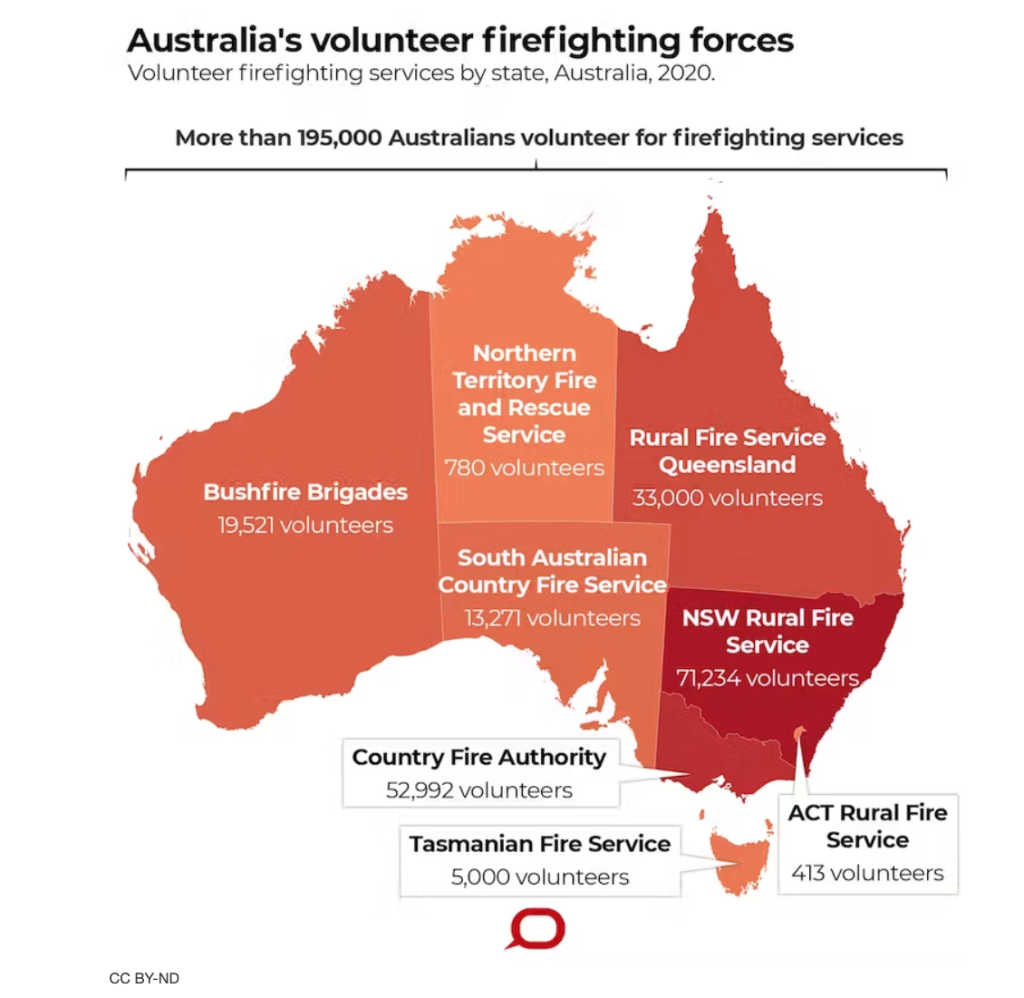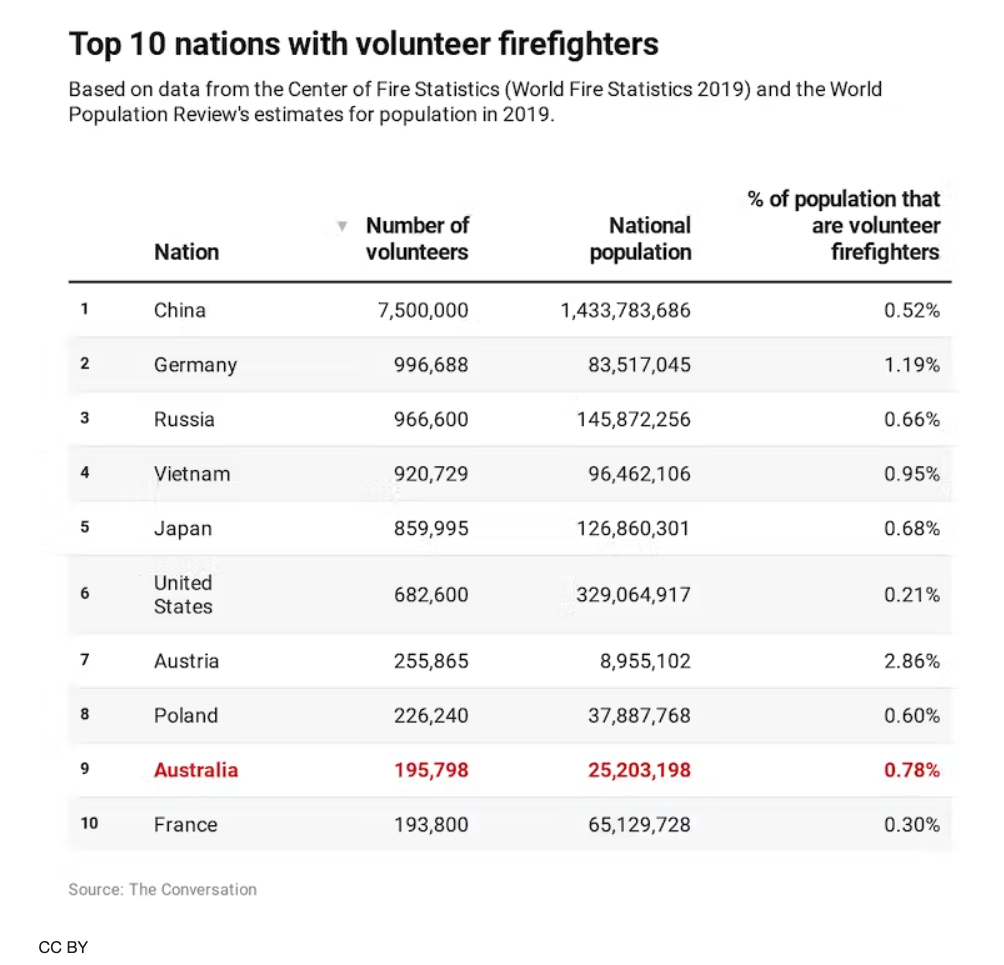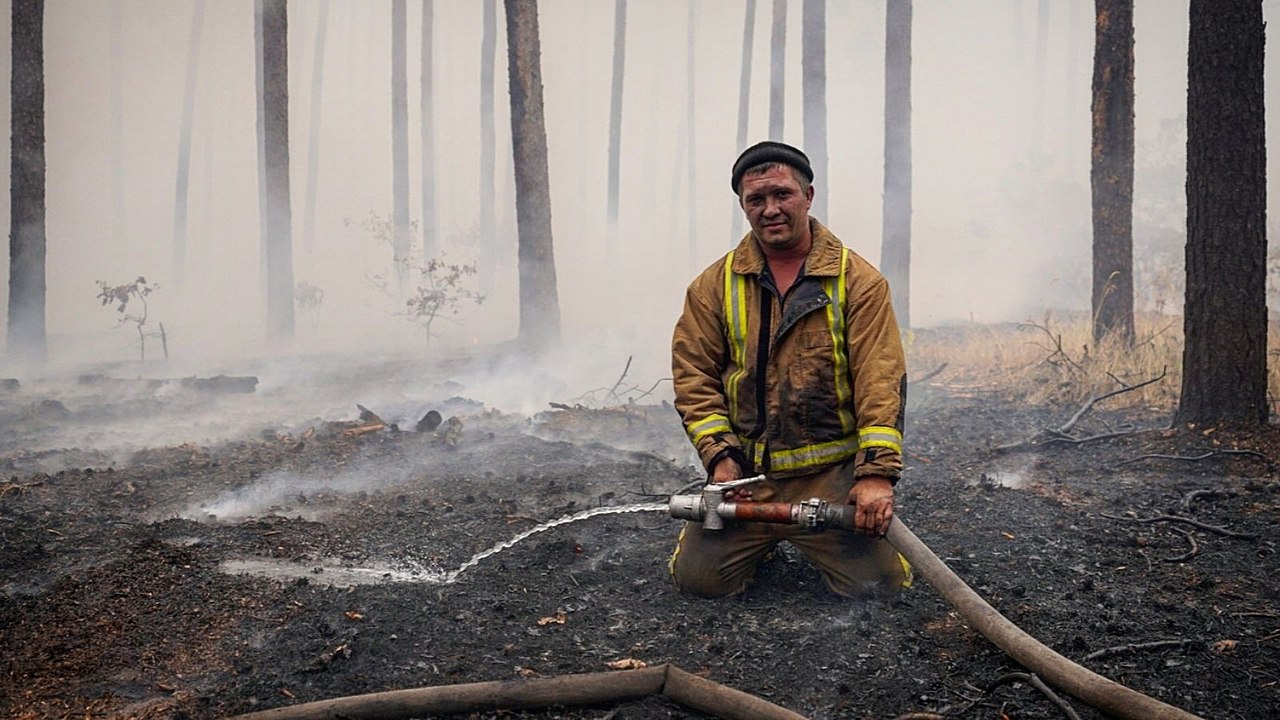Firefighting is a hazardous job, especially during severe wildfire seasons. As we brace ourselves for the upcoming summer, there is a looming concern about pushing our wildland firefighters to their limits once again, making this season potentially the most critical since the devastating 2019-2020 Black Summer fires. With the influence of climate change and both a positive Indian Ocean Dipole (IOD) and El Niño, our firefighting crews will face unprecedented and unpredictable conditions.
The Emergency Leaders of Climate Action (ELCA) emphasised that even the increased deployment of very large air tankers during the 2019-20 bushfires had minimal impact on containing the wildfires. As the fires became mega-fires, a shortage of firefighters and limited resources posed a significant challenge to containing the escalating infernos. The prediction by the fire chiefs that substantial rainfall was the only solution to extinguish the fires was proven correct when heavy downpours finally extinguished the fires in NSW and Victoria in February 2020.
In this context, it is crucial to acknowledge that the majority of rural bushfire fighters are volunteers, motivated by a strong sense of communal responsibility. Australia heavily relies on these volunteers due to the country’s vastness and susceptibility to bushfires. What unites all wildland firefighters, whether they serve as paid professionals or volunteers, is their unwavering commitment to safeguarding their community, often at the expense of both their physical and mental well-being.
 Australia’s volunteer firefighting forces Source: The Conversation
Australia’s volunteer firefighting forces Source: The Conversation

Given their selfless commitment, shouldn’t we prioritise ensuring their safety to the fullest extent possible?
One approach is simple: Detect fires early to rapidly contain and extinguish them before they get out of control and overwhelm firefighting capabilities. The significance of early detection cannot be overstated. This blog post highlights the profound mental and physical challenges that firefighters face and underscores the critical importance of swift wildfire detection in preserving their overall well-being.
Health risks for Firefighters associated with Wildfires
The increasing impact of bushfires has drawn attention to firefighters’ health risks. Wildland firefighters encounter unique health risks, distinct from those structural firefighters face. The diverse fuel sources found in open landscapes, such as grass, trees, and fallen branches, as well as the influence of terrain on fire behaviour present different threats and strategies involved in tackling the fire.
During a severe wildfire, cyclonic winds can form as the hot gases rise and create a vacuum, drawing air from miles away to feed the fire and causing sudden wind storms, altering the fire’s course. Fire conditions can rapidly evolve, transitioning from a single fireline to a massive firefront within minutes due to wind changes. Numerous properties are at risk during these intense episodes, particularly homes built amidst dense bush without natural or manmade fire breaks. Unfortunately, the favoured locations for buildings, such as hilltops and ridges for scenic views, pose the highest risks during a wildfire.
Limited escape routes and exposure to unpredictable fire behaviour make firefighters’ circumstances exceptionally challenging and raise the risk of fatality.
Mental Health Impact
Climate change exacerbates wildfires, leading to increased mental health challenges and burnout among firefighters globally. Enduring 12 to 36-hour shifts in gruelling conditions takes a mental toll, with the loss of comrades adding to the emotional strain. Despite their heroic image, firefighters have their breaking points.
They juggle the responsibilities of battling fires and providing comfort to devastated communities. The toll is evident on their faces as the feeling of helplessness lingers. The story of a Cal Fire Battalion Chief illustrates the profound impact of traumatic experiences on the firefront. In 2018, the Camp Fire devastated his hometown of Paradise, California, taking lives and destroying thousands of structures, including his childhood home.
Haunted by the memories of searching for human remains in the rubble and witnessing the destruction of his beloved community, he found it impossible to shake off the trauma. His battle with anger, frequent outbursts, and strained relationships with his family pushed him to seek help. Eventually, he joined a therapeutic retreat that equipped him with coping mechanisms and a better grasp of his emotional struggles.
Mental Health Stigma
Despite their resilience in handling stressful situations, firefighters often grapple with mental health issues like PTSD, anxiety, depression, and substance abuse. Most (92%) feel the pressure to “toughen it out,” preventing them from seeking help due to prevailing stigmas. Many suffer silently, carrying the heavy burden of traumatic memories that refuse to fade and hoping that things will improve if they wait long enough.
Sadly, some spiral into deep depression, leading to tragic outcomes like suicide. For those who do seek help, a diagnosis of post-traumatic stress disorder (PTSD) marks the beginning of a challenging journey with a long and difficult path to recovery.
In addition to this weight, they face the heart-wrenching news that they can no longer continue as active firefighters. This devastating blow intensifies their struggle as they grapple not only with the loss of their career but also with a fundamental part of their identity.
Post-Traumatic Stress Disorder (PTSD)
Firefighters often struggle with post-traumatic stress disorder (PTSD) due to their exposure to distressing and traumatic events. The intense and life-threatening situations they encounter can have a lasting impact, triggering heightened emotional responses, anxiety, and recurring flashbacks. The nature of their work, which requires quick decision-making and managing high-stress scenarios, can contribute to the development of PTSD. Over time, these experiences can significantly affect their mental well-being, underscoring the importance of providing the necessary support and resources to address their psychological struggles.

Unseen Scars of Depression and Anxiety
Prolonged exposure to traumatic events and the demanding nature of firefighters’ work can lead to persistent periods of low mood and heightened anxiety. The weight of their responsibilities, the constant need to remain vigilant, and the unpredictable nature of emergencies can affect their mental health. It leaves unseen scars of depression and anxiety that can intensify over time, draining their motivation and energy and even affecting their relationships. Left unaddressed, this can potentially lead to substance abuse and an increased risk of suicide.
Physical Health Impact
Firefighters confront numerous job-related hazards, including heat exhaustion, burns, and physical stress. They frequently encounter elevated levels of carbon monoxide and other toxic dangers, heightening the likelihood of various diseases. Firefighters who partake in unhealthy habits, particularly smoking, face an even greater risk. Smoking amplifies the chances of developing heart disease, cancer, respiratory ailments, and stress-related issues and adversely affects treatment outcomes for specific diseases like hepatitis. In a comprehensive long-term health study conducted in 2016, approximately 1,000 Canadian firefighters were examined, revealing an increased likelihood of asthma development, diminished lung function, and bronchial wall thickening attributed to their prolonged exposure to smoke.
Heart Disease
The risk of cardiovascular disease is increased in firefighters. Heart attacks are the leading cause of death, constituting 45 percent of all work-related firefighter fatalities. Potential factors contributing to increased risks include exposure to smoke, particulate matter, adrenaline surges, and various chemicals encountered during firefighting. These risks are further exacerbated by poor physical fitness, excess weight, and smoking.
Cancer
Recent findings from the Journal of Occupational Medicine, led by Dr. Anna Stec, Professor at the University of Central Lancashire, have shed light on the alarming health risks faced by firefighters. The study has revealed a significantly elevated risk of specific cancers, including prostate, leukemia, and esophageal cancer, with rates 1.6 times higher than those in the general population. The research underscores the potential link between these health concerns and exposure to carcinogenic substances such as benzene and polycyclic aromatic hydrocarbons, which are commonly released during fire incidents.
Chronic Respiratory Disease
Even with protective gear, seasoned firefighters remain susceptible to chronic respiratory diseases due to prolonged exposure to smoke, toxins, and other harmful substances during their operations. The cumulative impact of repeated exposure to these dangerous elements can lead to the development of respiratory issues like chronic bronchitis, asthma, and chronic obstructive pulmonary disease (COPD). Inhaling toxic particles and noxious gases from smoke can cause lasting harm to the respiratory system, resulting in persistent coughing, wheezing, and difficulty breathing. Moreover, firefighters who smoke are particularly at risk of enduring significant and irreversible lung damage due to prolonged exposure to various respiratory hazards.
Inadequate Firefighting Resources
Swift intervention is crucial for containing wildfires. However, many departments face significant challenges in recruiting and retaining firefighting personnel. Budget limitations and funding constraints worsen these issues, leading to reduced staffing levels, outdated equipment, and insufficient training resources.
Cathy Noakes, a former member of the New South Wales Rural Fire Service (RFS), left the organisation in 2014 after over a decade of active service, including three years as the captain of her brigade in Farringdon. Her decision was driven by frustrations with the RFS bureaucracy, which hindered their ability to act swiftly during emergencies. This sentiment echoes the broader concern among volunteer firefighters, as their numbers have decreased by 15% over the past ten years. The lack of support following the Black Summer fires has further fueled discontent, prompting volunteers to advocate for more localized control in firefighting operations. The restrictive approval processes enforced by the RFS led to delays in firefighting efforts, allowing fires to escalate unchecked.
The resulting personnel shortage creates a demanding and risky working environment for firefighters, allowing fires to spread and posing heightened risks for both the firefighting teams and the communities they serve. Urgent action is needed to address these systemic challenges and ensure the safety and effectiveness of firefighting operations as wildfire incidents continue to escalate.
How to Mitigate the Mental and Physical Health Impact on Firefighters?
Building a Supportive Culture: Prioritising Mental Health
To combat the stigma surrounding mental health, it is crucial to foster a supportive environment within fire stations that normalises discussions about mental well-being and encourages open communication. Providing comprehensive training for leaders and firefighters to recognise and address mental health concerns, as well as integrating mental health education into firefighter training programs, can offer vital support to firefighters. Fire emergency departments must prioritise mental health resources, treatments, and support, acknowledging the inherent risks of the profession and the need for robust support systems.
Early Wildfire/Bushfire Detection
When fires grow into mega-fires, managing them becomes increasingly difficult because they cover vast areas, sometimes stretching hundreds or even thousands of kilometres. Dealing with multiple mega-fires simultaneously creates obvious problems with limited resources, forcing fire agencies to make tough choices about risks, how to use what’s available, and how to handle increasingly scarce equipment.
As the number of fires increases, the resources to fight them decrease, making it more likely that new fires will quickly get out of control. Consequently, trying to control these massive fires becomes impractical and ineffective. Fire services often have to prioritise containing the fires as much as possible and safeguarding people’s lives and assets, especially during severe fire weather conditions.
ELCA’s Recommendations for Mega-Fire Prevention
The Emergency Leaders for Climate Action (ELCA) pointed out in their submission to the Senate Inquiry following the 2019-20 Australian bushfire season that no new firefighting techniques or strategies have been demonstrated to combat mega-fires effectively. However, drawing on centuries of combined experience, ELCA emphasised that concerted efforts can be made in three key areas to prevent the development of mega-fires:
- Swift and accurate fire detection and location capabilities.
- Prompt aerial initial response to contain fires until ground crews arrive.
- Rapid deployment of highly trained remote area fire teams.
In addressing the pressing need to detect and respond to bushfires swiftly, particularly during Severe, Extreme, and Catastrophic fire danger rating days, ELCA recommended the implementation of innovative early wildfire detection technologies that trigger an appropriate initial response, deliver critical situational data, and aid tactical and operational decision-making. Once new fires are identified, an immediate response and sufficient resources, including the appropriate number of aircraft, tankers, and personnel, are crucial to restricting the spread of the fire.
Early detection not only aids in swift and effective fire containment but also plays a crucial role in minimising firefighters’ exposure to the hazardous components of bushfire smoke, reducing the risks of respiratory issues, cancer, and other chronic health ailments. Yet, the detection of wildfires heavily relies on public calls to emergency services, which can take up to 90 minutes after ignition. exci provides an unequalled, innovative solution to this global problem.
exci’s AI-Wildfire/Bushfire Detection Technology
A critical factor in reducing the severity of a bushfire is the time between ignition, detection, and first attack response. While traditional fire lookouts served as the primary detection method in the past, technological advancements such as camera monitoring replaced them over time. Nonetheless, the continuous monitoring of cameras requires sustained human vigilance, posing challenges in maintaining focus during prolonged observations of gradually changing images.
Furthermore, it involves significant costs to maintain a dedicated team for round-the-clock camera surveillance. Leveraging Artificial Intelligence (AI) presents a viable solution to this problem. AI works tirelessly, swiftly processing and analyzing data with unparalleled accuracy, surpassing the limitations of human capabilities.
exci has effectively employed advanced AI models (deep machine learning algorithms) in its early wildfire detection system, trained on extensive datasets comprising over one billion ground-based camera images and more than 500,000 satellite images. This system is adept at swiftly identifying the presence of smoke and heat with exceptional accuracy and speed. Notably, exci’s system detects even small fires, as tiny as a garden shed, within minutes of ignition, boasting an impressively low rate of false positives.
During the 2021 Californian fire season, exci monitored nearly 130 Million acres and issued 8.672 fire notifications. In Australia, exci’s system covers an expansive network spanning over 25 million acres, extending from Victoria to Northern Queensland. Since the launch of exci’s system four years ago, exci successfully detected an astounding 121,000 fires and counting as of October 2023.
by Gabrielle Tylor
exci – The Smoke Alarm for the Bush
AI-Assisted Fire management Tool
6 November 2023
Don’t let hazardous events become catastrophic!
Contact our friendly team today for a comprehensive demonstration of exci’s system and discover how it can protect your assets while also protecting your community.
email: info@exci.ai
International Phone: +61 458 594 554
Visit our website at https://www.exci.ai/ to learn more and take the first step towards a safer and more resilient future

